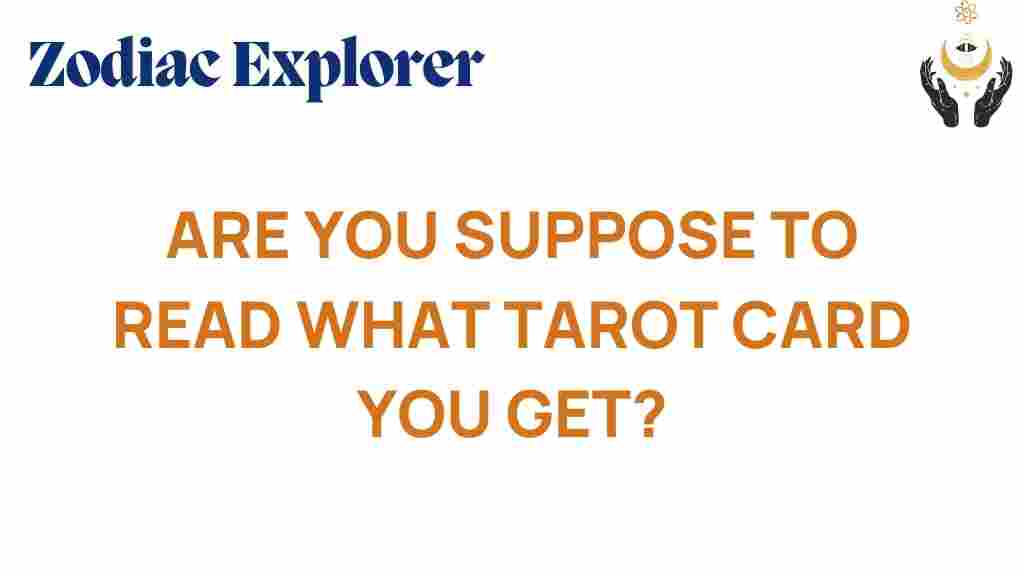Unveiling the Mystery: Should You Interpret Every Tarot Card?
Tarot has long been a revered tool for divination, offering insights into our lives, challenges, and paths. Whether you are a novice or an experienced tarot reader, the question often arises: should you interpret every tarot card in a reading? This article will delve into the intricate world of tarot, exploring the nuances of card interpretation, the significance of intuition in reading, and how to harness the symbolism of each card for guidance and self-discovery.
The Essence of Tarot and Card Interpretation
At its core, tarot is a powerful system of divination that utilizes a deck of cards—traditionally 78 in total—to tap into deeper layers of intuition and spiritual understanding. Each card is rich with symbolism, representing different aspects of life, emotions, and experiences. But how do you approach card interpretation effectively?
- Understanding Symbols: Each tarot card carries unique symbols that can provide profound insights.
- Intuitive Reading: Trusting your instincts can lead to more personalized interpretations.
- Context Matters: The position of a card in a spread can influence its meaning.
The Role of Intuition in Tarot Reading
While studying the meanings of tarot cards is essential, intuition plays a critical role in tarot reading. Here’s how you can enhance your intuitive abilities:
- Practice Regularly: The more you work with your tarot cards, the more in tune you will become with your intuition.
- Quiet Your Mind: Meditation can help clear your thoughts and make way for intuitive insights.
- Keep a Tarot Journal: Documenting your readings can reveal patterns and deepen your understanding of card meanings.
Should You Interpret Every Tarot Card?
When conducting a tarot reading, you may wonder whether you should interpret every card that appears. The answer is nuanced and depends on several factors:
The Purpose of the Reading
Consider what you aim to achieve with your tarot reading. If you seek general guidance, interpreting all cards can provide a comprehensive view. However, if you are focused on a specific question, only the cards that directly relate to that query may need interpretation.
The Spread Used
The type of spread you choose can also determine whether all cards need interpretation. For instance:
- Three-Card Spread: Often focuses on past, present, and future, making every card significant.
- Celtic Cross: A more complex spread that may require selective interpretation based on the question.
Personal Connection to the Cards
Your personal connection to each card can influence your decision. Some cards may resonate more deeply with you, prompting a more in-depth interpretation, while others might seem less relevant at that moment.
Step-by-Step Process for Card Interpretation
To effectively interpret tarot cards, follow this structured approach:
Step 1: Set Your Intention
Before you draw cards, establish a clear intention or question. This focus will guide your interpretation of the cards.
Step 2: Choose Your Spread
Select a tarot spread that aligns with your intention. Different spreads serve various purposes, and the right choice can enhance your reading.
Step 3: Draw Your Cards
Shuffle your deck and draw the cards according to your chosen spread. Pay attention to your feelings as you draw each card.
Step 4: Analyze Each Card
Look at the imagery, symbolism, and traditional meanings of each card. Ask yourself questions like:
- What does this card represent in the context of my question?
- How does this card relate to the other cards drawn?
- What intuitive feelings arise while observing this card?
Step 5: Synthesize Your Findings
After analyzing the cards, combine your insights to form a cohesive interpretation. Consider how the cards interact with one another to provide a broader narrative.
Troubleshooting Common Card Interpretation Issues
Issue 1: Confusion Over Card Meanings
If you find yourself confused about a card’s meaning, try:
- Consulting your tarot guidebook for traditional interpretations.
- Reflecting on your personal experiences and feelings related to the card.
Issue 2: Overthinking Your Reading
Sometimes, the pressure to provide deep insights can lead to overthinking. To counter this:
- Trust your intuition; often, the first impression you have is the most accurate.
- Take breaks during your reading to clear your mind.
Issue 3: Disconnection from the Cards
If you feel disconnected from the cards, consider:
- Spending time meditating with each card individually.
- Engaging in creative activities, such as drawing or writing, to deepen your connection.
Conclusion: Embrace the Journey of Self-Discovery
Interpreting tarot cards is a deeply personal journey that intertwines spirituality, intuition, and symbolism. Whether you choose to interpret every card or focus only on those that resonate, the most important aspect is to remain open to insights and guidance. As you delve deeper into the world of tarot, remember that each reading is an opportunity for self-discovery and growth.
For further exploration of tarot and its intricacies, consider visiting this comprehensive guide to tarot reading. And if you’re eager to enhance your understanding of symbolism in tarot, check out this insightful article on tarot symbolism.
This article is in the category Myths and created by ZodiacExplorer Team
